6 Things We Only Believe Today Because Of Propaganda

The Man wants us to believe any number of ridiculous things, from trickle-down economics to tinfoil hats being "crazy." Right, like "Tubthumping" just gets stuck in your head out of nowhere -- we know what cellphone towers really do, whitey. We accept such absurd concepts as the obvious lies they are; untruths perpetuated solely to further powerful interests. But some of the most seemingly innocent facts we never even think to question were in fact originally churned out by the propaganda machine. For example ...
Tobacco Companies Invented Type A/B Personalities To Avoid Blame For Heart Attacks
Type A personalities are stressed workaholics prone to angry outbursts, while Type Bs are more relaxed and agreeable. Those are all of the types. Clearly, there are no people who fall outside of those definitions.
Don't Miss
But why did such a reductive categorization take hold in American culture? Oddly enough, it's because of cigarettes. It turns out that for years, the tobacco industry was involved in both financially influencing studies about and propagating the idea of this binary personality system. Yep, Type A / Type B personalities are "to a large extent a construct of the tobacco industry."
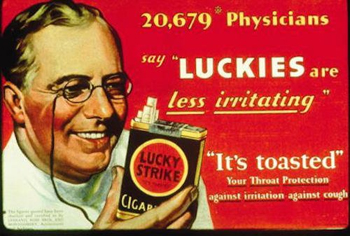
See, Big Tobacco needed to come up with a reason people who smoked were more prone to heart attacks, but for some reason didn't want to say "our bad." They eventually settled on the idea that some people are just naturally on the verge of blowing an artery all the time, and if those same people also tended to de-stress with nicotine, then the connection between smokers and people who have heart attacks would be nothing more than a coincidence. They proceeded to fund every psychological study that pushed the two personality types, then did everything they could to make sure the American public accepted it. So the next time you hear someone describe themselves as a real "Type A" personality, tell them the truth about where that comes from. Then, for fun, tell them to calm down. Listen close and you might even hear the artery pop!
It's Only "Spanish Flu" Because Spain Was The First To Admit It Was Happening
In 1918-1919, there was a huge flu outbreak that seemed to hit all parts of the globe almost simultaneously, like a pirated episode of Game Of Thrones, only slightly more grim. The virus was 25 times more lethal than previous flu outbreaks, and 50-100 million worldwide died from it. It didn't help that nobody wanted to report it because there happened to be a world war going on, and no one wanted "discouraging news" coming out of their country. This was before quick, personal long-distance communication was practical, so it's not like you could text your buddy in England "lol diying of flu wyd."
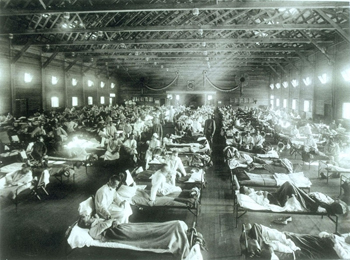
Spain, a neutral party during WWI, was the first to report massive numbers of deaths, because they figured that massive numbers of deaths were a thing worth reporting. But after Spain named the elephant in the room, the rest of the world repaid them by reporting their own casualties as being due to the "Spanish flu." It appears that global pandemics function on "they who smelt it, dealt it" rules. Which is weird, because one of the first cases of "Spanish flu" was traced to Kansas, two months before the first case in Spain. Kansas may have even been the origin point, according to historical evidence. They don't even have a good tapas bar, yet they managed to create the Spanish flu.
The Cuban Missile Crisis Was A Diplomatic Success, Not A Political Dick-Measuring Contest
The standard narrative of the Cuban Missile Crisis goes like this: On October 24, 1962, Russians tried to put nukes in Cuba, and JFK went "eyeball to eyeball" with them, and never blinked. It's the reason the U.S. is rarely willing to budge when another party wants to negotiate, thinking "All I have to do is swing my big American dick around like Kennedy, and my foe will crumble beneath its mace-like blows."
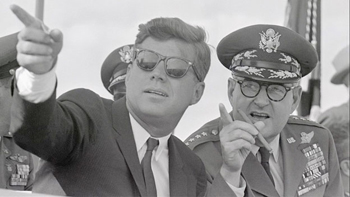
But the story of the Cuban Missile Crisis is just that: a story. It didn't happen the way you've been taught, and we only believe what we do because the Kennedy administration actively misled the public about the crisis. You probably think Soviet ships were on the cusp of crossing the blockade line when Kennedy unzipped, but in reality, the lead ship was already 750 miles away by that point. If Kennedy swung his dick, it was at their quickly retreating backs -- a gesture he was likely familiar with.
An integral part of the mythos is that Kennedy made no concessions during the crisis, but he and Nikita Khrushchev had already negotiated beforehand, with both making huge concessions. The Soviets didn't turn away until Kennedy guaranteed he would never invade Cuba, and they would only take their missiles home if America took their Jupiter missiles out of Turkey. (Which, by the way, was the whole reason Russia was moving missiles to Cuba -- America had already done the same thing, but in Turkey.) Then JFK went home and played the diplomatic equivalent of that kid in grade school who insists he's a Black Belt in "Tae Karate Do."
So-Called "Tulip Mania" Was Calvinist Propaganda
The famed Dutch tulip craze is the oft-repeated example about the dangers of economic bubbles. Unfortunately, pretty much every wild "Tulip Mania" story -- the economy collapsing, certain breeds eclipsing mansions in price, citizens being jailed for accidentally eating a tulip bulb -- was made up by Calvinists, a once-influential branch of the Protestant church that has somewhat dwindled in modern times, probably thanks to, y'know, all these lies.
Yes, there really was a Dutch tulip craze, but it had about as much effect on the economy as Beanie Babies.
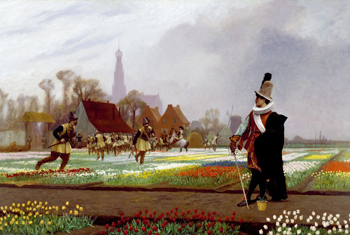
Rare breeds did indeed fetch a high price, but they were luxury items, like premium headphones these days. If Dr. Dre went bankrupt tomorrow, you wouldn't call that an economic crisis. And nobody even went bankrupt when tulips inevitably fell out of fashion. They simply moved on to the next big things -- presumably dank herb and loose women, which also happen to be interests of Dr. Dre.
Which is where the Calvinists come in. They began circulating pamphlets decrying the devil's perennial with the aforementioned myths, and the tales caught on. Why did the Calvinists choose to take up this, of all mantles? They felt that rampant consumerism, as symbolized by the tulip industry, would lead the country away from God, turning the Netherlands into a den of sin. And ... well, were they wrong?
The Enemy At The Gates Sniper Duel Was Pure Myth
The duel between Nazi sniper instructor Major Konig and ordinary Soviet citizen turned expert killer Vasily Zaitsev is so legendary that it got its own movie, Enemy At The Gates.
It's an epic tale of the underdog defeating almighty evil, overcoming the odds through sheer pluck and creativity. It's The Karate Kid, basically. The Karate Kid with guns. And Nazis. And it almost certainly didn't happen.

The Nazis had no records of either a "Major Konig" or the school where he supposedly taught. Say what you will about the Nazis, but they were meticulous note-takers. The opponents' stated positions are inconsistent with historical record, and attempts to pinpoint exactly when this happened have been met with little more than dismissive hand-waving. But Zaitsev's winning shot -- his crane kick, as it were -- seems the most ridiculous. His story is that he waited it out until the afternoon sunlight was at the perfect angle to reflect off Konig's scope, giving away his position. This wasn't merely a Nazi sniper; this was the guy who taught Nazi snipers. Why would he make such a rookie mistake?
So what really happened? At best, Zaitsev shot some Nazi nobody, and the USSR propaganda machine took control to boost morale. At worst, they made the story up completely, and Zaitsev went along with it. Good thing we live in a country where nobody would ever make up some elite sniper BS and use it as jingoistic propaganda.
Roosevelt Didn't Spare That Teddy Bear
Teddy Roosevelt is a man of many legends, most of them deserved. It's said that one day in 1902, while hunting in the backwoods of Mississippi, Teddy was offered the opportunity to kill a captured bear. This was the early 20th century version of letting your guest have the biggest chicken wing. Appalled by the gesture, and out of solidarity for his fellow beast, Roosevelt spared its life. This whole thing inspired a local toymaker to create the "teddy bear." Honestly, it's weird that more iconic toys don't come out of hunting mishaps.
Of course, it's obvious this story is bullshit as soon as you hear that Roosevelt let the bear go without trying to wrestle it. In actuality, he did refuse to kill the bear ... but then ordered his helpers to kill it for him. They slit its throat and carried it back to camp, where they all dined on roasted bear over the course of several days. It's not clear why anyone felt the need to make up a story when "I heard he once ate a whole bear" was right there. It is clear, however, who did it: That most wretched of creatures, the political cartoonist.
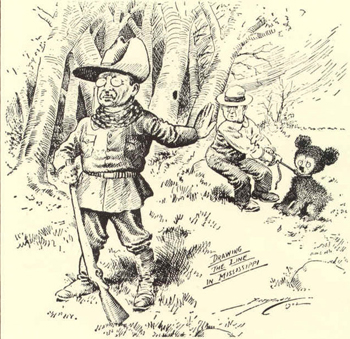
It was this cartoon that inspired the creation of the teddy bear, a toy which itself went on to become a symbol of the Republican Party during the 1904 elections. These toy bears were handed out as promotional materials intended to associate Roosevelt with family values and softness, which had to have been his campaign manager's idea. If Roosevelt had his way, every voter would have gotten a swift punch in the mouth, which he called "a gentleman's handshake."